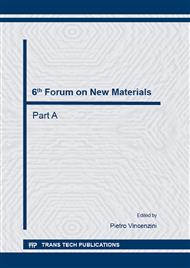[1]
A. Samanta, A. Zhao, G.K.H. Shimizu, P. Sarkar, R. Gupta, Post-Combustion CO2 Capture Using Solid Sorbents: A Review, Ind. Eng. Chem. Res. 51 (2012) 1438-1463.
DOI: 10.1021/ie200686q
Google Scholar
[2]
D.M. D'Alessandro, B. Smit, J.R. Long, Carbon dioxide capture: prospects for new materials, Angew. Chem. Int. Ed. 49 (2010) 6058-6082.
DOI: 10.1002/anie.201000431
Google Scholar
[3]
N.P. Wickramaratne, M. Jaroniec, Importance of small micropores in CO2 capture by phenolic resin-based activated carbon spheres, J. Mater. Chem. A 1 (2013) 112-116.
DOI: 10.1039/c2ta00388k
Google Scholar
[4]
J.P. Marco-Lozar, M. Kunowsky, F. Suárez-García, J.D. Carruthers, A. Linares-Solano, Activated carbon monoliths for gas storage at room temperature, Energy Environ. Sci. 5 (2012) 9833-9842.
DOI: 10.1039/c2ee22769j
Google Scholar
[5]
J.P. Marco-Lozar, M. Kunowsky, F. Suárez-García, A. Linares-Solano, Sorbent design for CO2 capture under different flue gas conditions, Carbon 72 (2014) 125-134.
DOI: 10.1016/j.carbon.2014.01.064
Google Scholar
[6]
J.P. Marco-Lozar, M. Kunowsky, J.D. Carruthers, A. Linares-Solano, Gas storage scale-up at room temperature on high density carbon materials, Carbon (2014), DOI: 10. 1016/j. carbon. 2014. 04. 058.
DOI: 10.1016/j.carbon.2014.04.058
Google Scholar
[7]
J. Zumerchik, Macmillan Encyclopedia of Energy, Macmillan Reference USA, New York, (2001).
Google Scholar
[8]
P. Patnaik, Handbook of Inorganic Chemicals, The McGraw-Hill Companies, Inc., New York, (2002).
Google Scholar
[9]
L. Schlapbach, A. Züttel, Hydrogen-storage materials for mobile applications, Nature 414 (2001) 353-358.
DOI: 10.1038/35104634
Google Scholar
[10]
M. Kunowsky, J.P. Marco-Lozar, A. Linares-Solano, Material Demands for Storage Technologies in a Hydrogen Economy, J. Renewable Energy, Article ID 878329 (2013) 1-16.
DOI: 10.1155/2013/878329
Google Scholar
[11]
G.D. Berry, S.M. Aceves, Onboard storage alternatives for hydrogen vehicles, Energy & Fuels 12 (1998) 49-55.
DOI: 10.1021/ef9700947
Google Scholar
[12]
M. Rzepka, P. Lamp, M.A. De La Casa-Lillo, Physisorption of hydrogen on microporous carbon and carbon nanotubes, J. Phys. Chem. B 102 (1998), 10894-10898.
DOI: 10.1021/jp9829602
Google Scholar
[13]
A.M. Seayad, D.M. Antonell, Recent Advances in Hydrogen Storage in Metal-Containing Inorganic Nanostructures and Related Materials, Adv. Mater. 16 (2004) 765-777.
DOI: 10.1002/adma.200306557
Google Scholar
[14]
K.L. Lim, H. Kazemian, Z. Yaakob, W.R.W. Daud, Solid-state materials and methods for hydrogen storage: A critical review, Chem. Eng. Technol. 33 (2010) 213-226.
DOI: 10.1002/ceat.200900376
Google Scholar
[15]
M. Jordá-Beneyto, M. Kunowsky, D. Lozano-Castelló, F. Suárez-García, D. Cazorla-Amorós, A. Linares-Solano, Hydrogen Storage in Carbon Materials, in: A.P. Terzyk, P.A. Gauden, P. Kowalczyk (Eds. ), Carbon Materials – Theory and Practice, Research Signpost, Kerala, 2008, pp.245-281.
DOI: 10.1002/9780470483428.ch8
Google Scholar
[16]
A. Linares-Solano, D. Lozano-Castelló, M.A. Lillo-Ródenas, D. Cazorla-Amorós, Carbon activation by alkaline hydroxides: preparation and reactions, porosity and performances, in: Chemistry & Physics of Carbon, Volume 30, 2008, pp.1-62.
DOI: 10.1201/9781420042993.ch1
Google Scholar
[17]
F. Suarez-García, M. Jordá, D. Lozano-Castelló, D. Cazorla-Amorós, A. Linares-Solano, Hydrogen adsorption on carbon materials at high pressures and different temperatures, in: Recent Advances in Adsorption Process, Springer, 2008, pp.165-175.
DOI: 10.1007/978-1-4020-6805-8_15
Google Scholar
[18]
A. Linares-Solano, D. Cazorla-Amorós, Adsorption on Activated Carbon Fibers, in: Adsorption by Carbons, Elsevier Ltd., 2008, pp.431-449.
DOI: 10.1016/b978-008044464-2.50021-3
Google Scholar
[19]
A. Linares-Solano, M.A. Lillo-Ródenas, J.P. Marco-Lozar, M. Kunowsky, A.J. Romero-Anaya, Utility of sodium and potassium hydroxides for preparing superior quality activated carbons, in: Hydroxides: Synthesis, Types and Applications, Nova Science Publishers, 2012, pp.73-104.
Google Scholar
[20]
A. Linares-Solano, D. Cazorla-Amorós, J.P. Marco-Lozar, F. Suárez-García, High pressure gas storage on porous solids; a comparative study of MOFs and activated carbons, in: Coordination Polymers & MOFs, Nova Science Publishers, 2012, pp.197-223.
DOI: 10.1016/j.ijhydene.2011.11.023
Google Scholar
[21]
A. Linares-Solano, D. Cazorla-Amorós, Activated Carbon fibers, in: Handbook of Advanced Ceramics, Academic Press: Elsevier Inc., second ed, 2013, pp.155-169.
DOI: 10.1016/b978-0-12-385469-8.00010-1
Google Scholar
[22]
D. Lozano-Castelló, F. Suárez-García, A. Linares-Solano, D. Cazorla-Amorós, Advances in hydrogen storage in carbon materials, in: Renewable Hydrogen Technologies: Production, Purification, Storage, Aplications and Safety, Elsevier, 2013, pp.269-291.
DOI: 10.1016/b978-0-444-56352-1.00012-x
Google Scholar
[23]
J. Alcañiz-Monge, D. Lozano-Castelló, D. Cazorla-Amorós, A. Linares-Solano, Gas storage - adsorbed natural gas (ANG) & hydrogen storage, in: Green Carbon Materials: Advances and Applications, Pan Stanford, (2013).
DOI: 10.1016/b978-0-444-56352-1.00012-x
Google Scholar
[24]
R. Chahine, T.K. Bose, Low-pressure adsorption storage of hydrogen, Int. J. Hydrogen Energy 19 (1994) 161-164.
DOI: 10.1016/0360-3199(94)90121-x
Google Scholar
[25]
M. Kunowsky, F. Suárez-García, A. Linares-Solano, Adsorbent density impact on gas storage capacities, Micropor. Mesopor. Mater. 173 (2013) 47-52.
DOI: 10.1016/j.micromeso.2013.02.010
Google Scholar
[26]
M. Kunowsky, J.P. Marco-Lozar, D. Cazorla-Amorós, A. Linares-Solano, Scale-up activation of carbon fibres for hydrogen storage, Int. J. Hydrogen Energy 35 (2009) 2393-2402.
DOI: 10.1016/j.ijhydene.2009.12.151
Google Scholar
[27]
A. Oya, N. Kasahara, Preparation of thin carbon fibers from phenol-formaldehyde polymer micro-beads dispersed in polyethylene matrix, Carbon 38 (2000), 1141-1144.
DOI: 10.1016/s0008-6223(99)00232-8
Google Scholar
[28]
D. Hulicova, A. Oya, The polymer blend technique as a method for designing fine carbon materials, Carbon 41 (2003) 1443-1450.
DOI: 10.1016/s0008-6223(03)00089-7
Google Scholar
[29]
M. Kunowsky, J.P. Marco-Lozar, A. Oya, A. Linares-Solano, Hydrogen storage in CO2-activated amorphous nanofibers and their monoliths, Carbon 50 (2012) 1407-1416.
DOI: 10.1016/j.carbon.2011.11.013
Google Scholar
[30]
D. Lozano-Castelló, D. Cazorla-Amorós, A. Linares-Solano, D.F. Quinn, Activated carbon monoliths for methane storage: influence of binder, Carbon 40 (2002) 2817-2825.
DOI: 10.1016/s0008-6223(02)00194-x
Google Scholar


